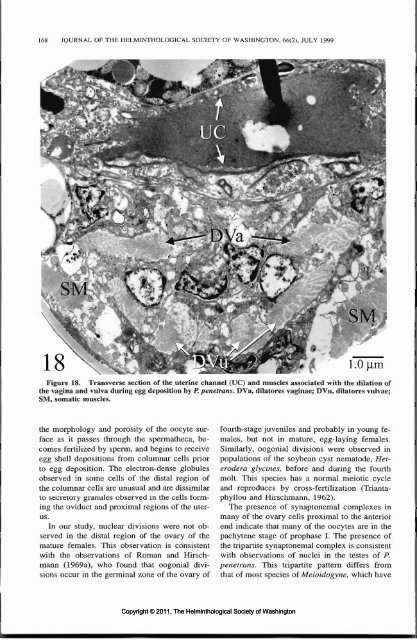The Helminthological Society of Washington - Peru State College
The Helminthological Society of Washington - Peru State College
The Helminthological Society of Washington - Peru State College
You also want an ePaper? Increase the reach of your titles
YUMPU automatically turns print PDFs into web optimized ePapers that Google loves.
168 JOURNAL OF THE HELMINTHOLOGICAL SOCIETY OF WASHINGTON, 66(2), JULY 1999<br />
SM<br />
v&J'BM<br />
•M$&L,<br />
KK^P<br />
sac «*•<br />
1.0 jim<br />
Figure 18. Transverse section <strong>of</strong> the uterine channel (UC) and muscles associated with the dilation <strong>of</strong><br />
the vagina and vulva during egg deposition by P. penetrans. DVa, dilatores vaginae; DVu, dilatores vulvae;<br />
SM, somatic muscles.<br />
the morphology and porosity <strong>of</strong> the oocyte surface<br />
as it passes through the spermatheca, becomes<br />
fertilized by sperm, and begins to receive<br />
egg shell depositions from columnar cells prior<br />
to egg deposition. <strong>The</strong> electron-dense globules<br />
observed in some cells <strong>of</strong> the distal region <strong>of</strong><br />
the columnar cells are unusual and are dissimilar<br />
to secretory granules observed in the cells forming<br />
the oviduct and proximal regions <strong>of</strong> the uterus.<br />
In our study, nuclear divisions were not observed<br />
in the distal region <strong>of</strong> the ovary <strong>of</strong> the<br />
mature females. This observation is consistent<br />
with the observations <strong>of</strong> Roman and Hirschmann<br />
(1969a), who found that oogonial divisions<br />
occur in the germinal zone <strong>of</strong> the ovary <strong>of</strong><br />
fourth-stage juveniles and probably in young females,<br />
but not in mature, egg-laying females.<br />
Similarly, oogonial divisions were observed in<br />
populations <strong>of</strong> the soybean cyst nematode, Heterodera<br />
glycines, before and during the fourth<br />
molt. This species has a normal meiotic cycle<br />
and reproduces by cross-fertilization (Triantaphyllou<br />
and Hirschmann, 1962).<br />
<strong>The</strong> presence <strong>of</strong> synaptonemal complexes in<br />
many <strong>of</strong> the ovary cells proximal to the anterior<br />
end indicate that many <strong>of</strong> the oocytes are in the<br />
pachytene stage <strong>of</strong> prophase I. <strong>The</strong> presence <strong>of</strong><br />
the tripartite synaptonemal complex is consistent<br />
with observations <strong>of</strong> nuclei in the testes <strong>of</strong> P.<br />
penetrans. This tripartite pattern differs from<br />
that <strong>of</strong> most species <strong>of</strong> Meloidogyne, which have<br />
Copyright © 2011, <strong>The</strong> <strong>Helminthological</strong> <strong>Society</strong> <strong>of</strong> <strong>Washington</strong>
















